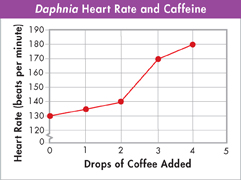What is the difference in kidney function of freshwater fishes and saltwater fishes?
Think Critically
Infer The excretory systems of terrestrial invertebrates, such as earthworms, convert ammonia to less toxic substances. Explain why this change is unnecessary in small aquatic invertebrates, such as planarians.
Apply Concepts Of all the nitrogenous wastes eliminated by animals, uric acid requires the least water to excrete. Why is the production of uric acid an advantage to animals that live on land?
Connecting Concepts
Use Science Graphics
A student conducts an experiment to measure the effect of caffeine on the heart rate of a small pond-water crustacean called Daphnia. The heart of this animal is visible through its transparent shell. With the help of a dissecting microscope, the student counts the heartbeats per minute before and after adding increasing amounts of coffee to the water surrounding the animal. Each data point in the graph at the top right represents the mean of five trials. Use the graph to answer questions 31 and 32.
Interpret Graphs Describe the effect of caffeine on the heart rate of Daphnia.
Predict What would be your prediction of the effect of five or more drops of coffee on the heart rate of Daphnia?
Write About Science
Explanation Write a paragraph in which you compare and contrast the structures and functions of the heart of a fish and the heart of a mammal.
Assess the
 Explain why a digestive tract is a more efficient structure for taking in and processing the food eaten by a large animal than a gastrovascular cavity would be.
Explain why a digestive tract is a more efficient structure for taking in and processing the food eaten by a large animal than a gastrovascular cavity would be.
Analyzing Data
A researcher conducted an experiment to see how air temperature affects the speed at which a snake can hunt for food. The experimenter placed the snake a fixed distance away from a piece of food and recorded the air temperature. Then, she recorded the time it took for the snake to reach the food. She repeated the experiment four times. Each time, the experimenter changed the air temperature. The data are shown to the right.
Interpret Tables At what temperature did the snake reach the food the fastest?
Analyze Data How did the time to reach the food change as the temperature increased?
Draw Conclusions What conclusion about snake hunting and temperature can you draw from the data?
Table of Contents
- Formulas and Equations
- Applying Formulas and Equations
- Mean, Median, and Mode
- Estimation
- Using Measurements in Calculations
- Effects of Measurement Errors
- Accuracy
- Precision
- Comparing Accuracy and Precision
- Significant Figures
- Calculating With Significant Figures
- Scientific Notation
- Calculating With Scientific Notation
- Dimensional Analysis
- Applying Dimensional Analysis






